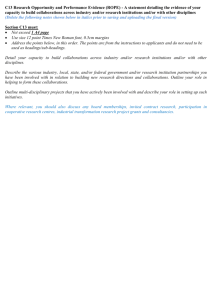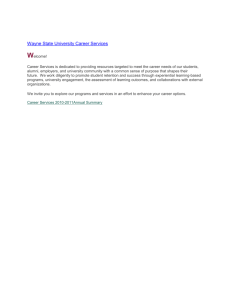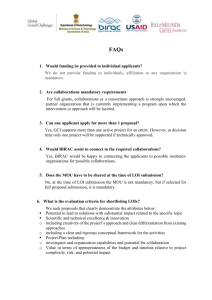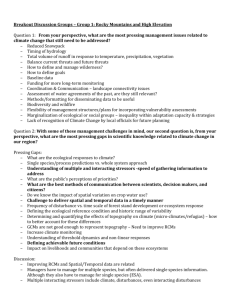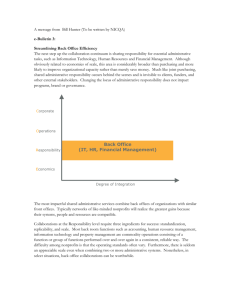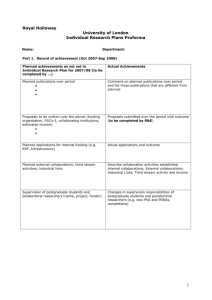SYLLABUS FOR PAD 5130 COLLABORATION ACROSS SECTORS
advertisement
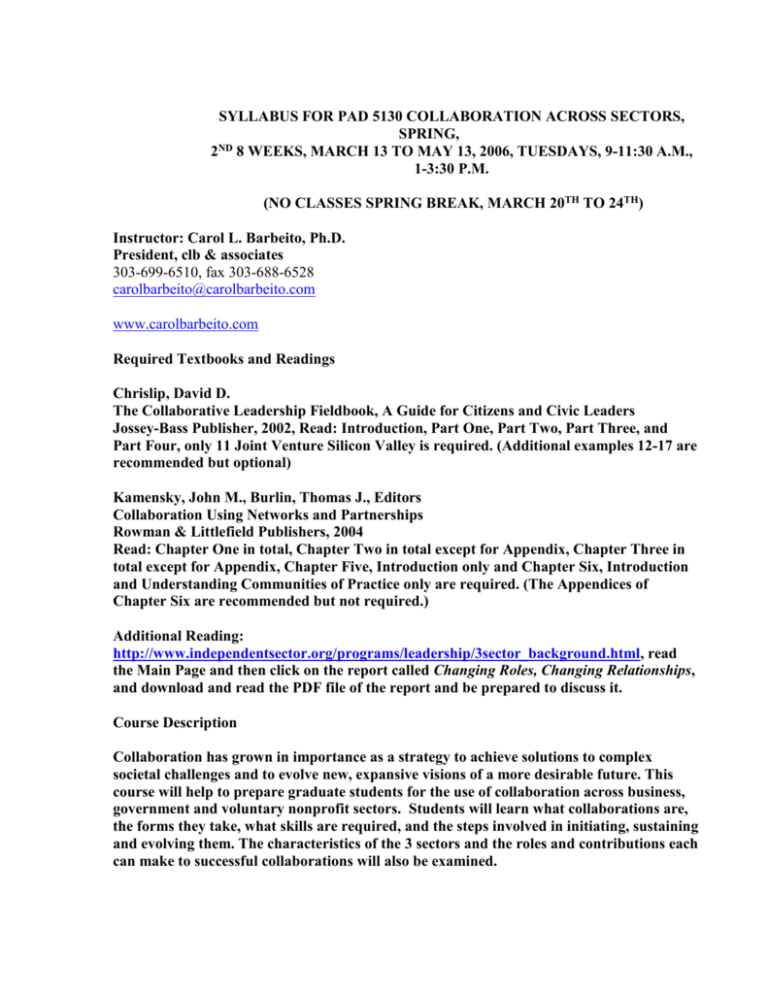
SYLLABUS FOR PAD 5130 COLLABORATION ACROSS SECTORS, SPRING, ND 2 8 WEEKS, MARCH 13 TO MAY 13, 2006, TUESDAYS, 9-11:30 A.M., 1-3:30 P.M. (NO CLASSES SPRING BREAK, MARCH 20TH TO 24TH) Instructor: Carol L. Barbeito, Ph.D. President, clb & associates 303-699-6510, fax 303-688-6528 carolbarbeito@carolbarbeito.com www.carolbarbeito.com Required Textbooks and Readings Chrislip, David D. The Collaborative Leadership Fieldbook, A Guide for Citizens and Civic Leaders Jossey-Bass Publisher, 2002, Read: Introduction, Part One, Part Two, Part Three, and Part Four, only 11 Joint Venture Silicon Valley is required. (Additional examples 12-17 are recommended but optional) Kamensky, John M., Burlin, Thomas J., Editors Collaboration Using Networks and Partnerships Rowman & Littlefield Publishers, 2004 Read: Chapter One in total, Chapter Two in total except for Appendix, Chapter Three in total except for Appendix, Chapter Five, Introduction only and Chapter Six, Introduction and Understanding Communities of Practice only are required. (The Appendices of Chapter Six are recommended but not required.) Additional Reading: http://www.independentsector.org/programs/leadership/3sector_background.html, read the Main Page and then click on the report called Changing Roles, Changing Relationships, and download and read the PDF file of the report and be prepared to discuss it. Course Description Collaboration has grown in importance as a strategy to achieve solutions to complex societal challenges and to evolve new, expansive visions of a more desirable future. This course will help to prepare graduate students for the use of collaboration across business, government and voluntary nonprofit sectors. Students will learn what collaborations are, the forms they take, what skills are required, and the steps involved in initiating, sustaining and evolving them. The characteristics of the 3 sectors and the roles and contributions each can make to successful collaborations will also be examined. Prominent guest lecturers will share their experiences in cross sector collaborations. Readings will provide additional case material to help students learn from real examples. Students will then apply what they have learned by planning for a cross sector collaboration of their own design. Learning Outcomes Students will understand what collaborations are and why they have emerged as an important strategy to achieve societal goals. Students will learn about the skills required for successful collaborations. Students will understand distinguishing characteristics of the business, governmental and voluntary nonprofit sectors and their roles and contributions in terms of cross sector collaborations. Students will learn the steps in initiating, sustaining and evolving collaborations and demonstrate this learning through design and class presentation of across sector collaboration. Policies and Expectations Students are expected to attend all class meetings, arriving on time and staying for the entire morning and afternoon sessions. Class participation is expected from all students each day with special emphasis on being present, prepared and engaged when Guest Lecturers are presenting. Assignments are time sensitive as the information and learning experiences build on one another and culminate in the application of the learning objectives through design and presentation of each student’s cross sector collaboration. Grading 500 points are available to be earned. 125 can be earned through active, informed, engaged attendance and participation. 125 can be earned from the test of the mastery of the first three learning objectives. 250 can be earned from the design and presentation to the class of a cross sector collaboration, and the constructive feedback provided to other students on their presentations. A = 425 - 500 B = 350 - 424 C = 300 - 349 D = 250 -299 F = 0 - 249 Reasonable Accommodation To request reasonable accommodation of physical and/or learning challenges, each student is responsible for obtaining a “disability verification letter” from the Office of Disability Services, Arts Building, Suite 177, 303-556-8387, TTY: 303-556-8484, Fax 303-556-2074 Course Agenda Tuesday, March 14, 2006 Welcome, introductions, discussion of experiences with collaborations, exploration of applicability of collaborations in student’s current and future life experiences. Course overview. Definition of collaboration. Importance of collaboration. Essential concepts of collaboration. Introduction to "A Guide to the Practices of Successful Collaboration", (Figure 5.1 p. 55, Collaborative Field Leadership) Guest Lecturer: Susan Turnquist, Ph.D., MPA Project Manager Awwa Research Foundation Dr. Turnquist will present a case on "Collaboration Across Sectors in Water Resources Development and Management". Description of Topic Most of us take water availability for granted nearly all of the time; we pay the bills and expect to have as much water as we wish, of the quality we need, whenever we wish, at the temperature we wish, for a reasonable cost. Yet this is a relatively recent development in human history; more than a billion people in the world today do not have any access to safe water, at any price, and in many parts of the world, including Colorado, we are up against absolute limits to existing sources of water. This presentation will discuss a range of water issues and how collaboration among sectors takes place to overcome limits to water quality, quantity, and distribution. The focus is on low-income Asia, but we can also discuss current issues in the USA and other high-income countries. Readings, The Collaborative Leadership Fieldbook, Introduction and Part One and Two Tuesday, March 21, 2006 Spring Break No class Tuesday, March 28, 2006 Characteristics of the business, voluntary nonprofit and government sectors. Guest Lecturer, Mike Rogue, Director, Denver Office of Strategic Partnerships will report on Mayor Hickenlooper’s commitment to working across sectors and on specific strategic partnerships that have been undertaken. He will highlight what he has found to be important to achieving success and will point out what he has experienced that has decreased the success of initiatives. Readings, Collaboration Using Networks and Partnerships, Chapter One http://www.independentsector.org/programs/leadership/3sector_background.html, Main page and report on "Changing Roles, Changing Relationships", read this selection and be prepared to discuss it. Web Search for Information on Collaborations, www.npgoodpractice.org and/or http://comnet.org/collaboratorycs/, Assignment: Review the sites for ease of access to relevant information on collaboration that supplements and compliments what we are covering in class. Document your experience in using the sites, (you may also explore other links the sites lead to) select one resource from your search and be prepared to share with the class the citation and a summary of the resource and why you selected it as especially relevant. (10 minute reports) April 4, 2006 Discussion and analysis of the Denver Strategic Partnerships Case. Student Reports on Resource Searches Skills required for success in building and leading collaborations. Guest Lecturer, Mike Mueller, Environmental Economist, Researcher and Community Activist, Guest Lecturer, Dr. Mueller will discuss his six years of service on the South Platte River Commission as an extended example of a collaboration between government, business, and volunteer/nonprofit NGOs. The SPRC was a blue ribbon commission appointed by the mayor of Denver in 1996 and I was one of the founding appointees. It was composed of about 25 members from federal, state, and local government, local business organizations, civic groups, and environmental organizations. Its purpose was the betterment of the S Platte River corridor through Denver. This included parks and trails development and improvement, business development, and riparian and aquatic habitat restoration and development. The SPRC was co-chaired by Mayor Web and Shea Homes vice president of Highlands Ranch, Joe Blake. Now Senator Salazar was its legal counsel. I plan to trace the history and development of the commission, its accomplishments and failures, the people involved, the politics involved, and its legacy. Readings: Collaborative Field Leadership, Part Four, Chapter 11, Joint Venture Silicon Valley only April 18, 2006 Test Discussion and analysis of the Mike Mueller Case Practices of Successful Collaborations Comparison of Joint Venture Silicon Valley Case with A Guide to the Practices of Successful Collaboration (Collaborative Leadership Fieldbook, Page 72, Figure 7.1 Guest Lecturer Linda Childears, President & CEO, Daniels Fund, will discuss how Bill Daniels, a highly successful business man, chose to work across sectors to use his business success to achieve impact on social issues he was concerned about. The focus of the case presentation will be the founding of the Young American’s Bank, and subsequently the Young American’s Center for Financial Education, highlighting the formation of the nonprofit organizations, the role of government and the cross sector collaborations involved. Linda Childears served as President of Young Americans Bank since its inception in 1987. Childears later spearheaded the start of the Young Americans Center for Financial Education and served as its President since its inception in 1990. Readings: Collaborative Leadership Fieldbook, Part 3 April 25, 2006 Discussion and analysis of the Linda Childears Case Practices of Successful Collaborations Continued Student proposals for collaboration design proposed, discussed and assignment clarified. Readings: Collaborations Using Networks and Partnerships, Part I, Chapter Two in total except of Appendix, Chapter Three in total except for Appendix May 2, 2006 Discussion of networks, communities of practice, virtual teams. Student outlines of collaboration design shared and discussed. Readings: Collaborations Using Networks and Partnerships, Part II, Chapter Five Introduction and Chapter Six Introduction and Understanding Communities of Practice May 9, 2006 Student Presentations on Collaboration Designs May 16, 2006 Student Presentations on Collaboration Designs Closing Summary Campus Closing Procedures The University has issued the following statement regarding campus closing procedures: “The decision to close the facilities for the day will normally be made prior to 6 a.m. You may call the Campus Snow/Info Line at 303-556-2401 .
